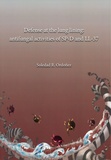Defense at the lung lining
Antifungal activities of SP-D and LL-37

Ordonez Alvarez, Soledad
- Promoter:
- Prof.dr. H.P. (Henk) Haagsman
- Co-promoter:
- Dr. M. (Martin) van Eijk & dr. E.J.A. (Edwin) Veldhuizen
- Research group:
- Haagsman
- Date:
- May 3, 2016
- Time:
- 16:15 h
Summary
Host defense proteins and peptides are part of the innate immune system of the lung. They constitute one of the first defenses against fungal pathogens during inhalation. Discerning how these molecular defenses act in concert to prevent infection in a healthy lung has proven to be difficult, due to a redundancy in function and the difficulty of mimicking the complex conditions of the lung environment in vitro. This thesis deals with the antifungal properties of two host defense molecules: the antimicrobial peptide LL-37 (a cathelicidin) and the surfactant protein D (SP-D). The approach taken was to extend our knowledge of these two molecules by first using simple in vitro settings and to use this information to develop a second setting where the conditions of the lung environment are mimicked. In this last model system the interactions with fungi and the environment (lung epithelial cells and immune cells) were also taken into account. We started by comparing the mechanism of action of two cathelicidins, LL-37 and CATH-2 (chicken homolog of LL-37), with that of Hist5, a human salivary antimicrobial peptide. Results indicate that, even though membrane destabilization seems to be the most prominent effect of the candidacidal activities of cathelicidins, internal targets also play a role and their importance remains to be determined. Secondly, we describe the interactions of SP-D with two fungal pathogens: Candida albicans and Aspergillus fumigatus in a simplified environment. SP-D binds C. albicans yeast and hyphae structures in a strictly Ca2+-dependent manner. In contrast, SP-D binding to A. fumigatus conidia and hyphae was only partially Ca2+-dependent. Interestingly, addition of LL-37 did not affect the binding of SP-D to both fungi. Finally we applied this gathered information into a more complex system that mimics the lung lining. To accomplish this Calu-3 cells were grown on an air liquid interface allowing them to form an environment similar to the one found at the lung lining. Neutrophils were also added to help clear the fungal infection in a later stage. The results obtained show that while LL-37 localized mainly at the mucus layer, SP-D remained at the apical side of epithelial cells. During infection LL-37 bound to the surface of A. fumigatus, but interestingly did not bind C. albicans cells. SP-D localized strongly to both fungal surfaces during the different stages of infection. Furthermore, SP-D decreased fungal association to the Calu-3 surface and increased fungal clearance by neutrophils. The work described in this thesis shows how important it is to take the lung environment into consideration if host defense molecules are studied. LL-37 showed a strong interaction with mucus that was not previously considered when the antifungal activity of this peptide was studied in a more simplified setting. The strong and selective binding of SP-D to fungal surfaces, described in this thesis, shows the importance of considering these types of interactions when fungal pathogens are studied at the lung lining. SP-D did not only significantly block the interaction between fungi and epithelium, but also increased antifungal activity of neutrophils.